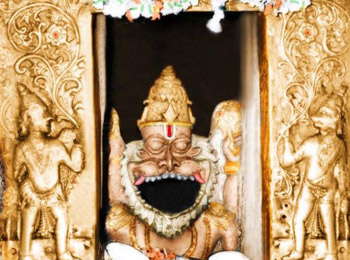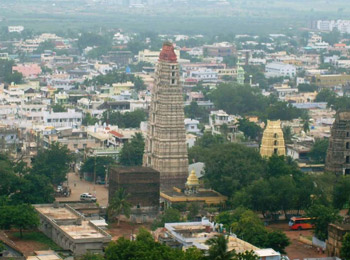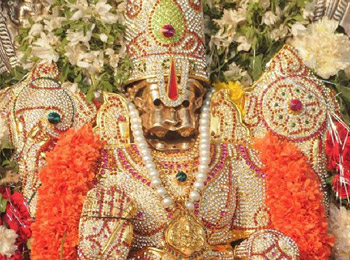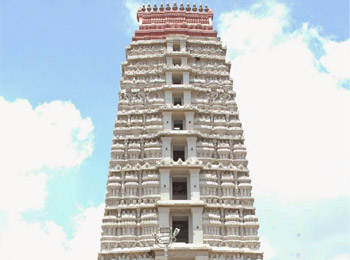- Vishnu
Panakala Narasimha Swamy Temple
- Mangalagiri,Andhra Pradesh
- View on map
- Tell us about this temple
Overview
The Sri Panaka Narasimha Swamy Temple, in Managalagiri is the habitation the God Narasimha. Mangalagiri implies The Auspicious Hill. Managalagiri, otherwise called Bhimadri is situated around 13 kilometeres from Vijaywada. The valiant Bhima of the Panadavas is said to have revered this God. The mountain is as an elephant with the temple situated in the elephant's mouth.
About the Temple

There is an intriguing legend to show regarding how the mountain appeared. Pariyatra, an old lord had a child Hrasva Srungi who went by all blessed and consecrated spots to recapture typical real stature lastly went to this heavenly place of Mangalagiri and stayed for a long time performing atonement. All the Devathas (Gods) exhorted him to stay at Mangalagiri and keep on doing atonement in applause for God Vishnu. The father of Hrasva Srungi accompanied his entourage to take back his child to his kingdom. In any case, Hrasva Srungi took the state of an elephant to turn into the residence God Vishnu in Sri Narsimha structure who is by regional standards known as Panakala Lakshmi Narasimhaswamy.
In Threthayugam, the four's second yugas, individuals who delighted in paradise as an aftereffect of their great deeds on the planet are most miserable to come back to this world (when once the products of good deeds are depleted, the spirit needs to return to the world). They implored Indra, the God of paradise to spare them from the looming destiny. Indra exhorted them to invest their energy on the planet at Mangalagiri to achieve paradise once more. In Krithayugam, the four's first yugas when the heathens were few, Yamadharmaraja, the God of hellfire prompted them to wash off their transgressions by doing atonement at Mangalagiri. Mangalagiri is in presence from the earliest starting point of the Universe with the names Anjanadri in Krithayugam, Thotadri in Threthayugam, Mangaladri and Mukthyadri in Dwaparayugam and Mangalagiri in Kaliyugam managing salvation to heathens too. In Krithayugam, Vaikhanasa Maharshi worshipped the God and his vigraham is venerated even today in the temple. It is additionally trusted that God Rama while leaving for Vaikuntam in the wake of finishing his central goal in that incarnation prompted Anjaneya to stay at Mangalagiri and in the wake of getting his gifts to stay in this world for ever. Anjaneya took his abode at Mangalagiri as Kshetrapalaka. Panakala Narasimha Swamy – God Who Drinks Panakam offered by dedicated bhaktas: A flight of stairs lead to the little temple on the slope. In 2004, ghat street had been built through which the explorers can achieve the temple effectively. It is said that here, God is self-existent (swayambhu) . A tall Dwajasthambam (raised in the year 1955) is found before the temple. Dissimilar to in numerous sanctuaries, one can't discover archa vigraham of the God aside from a wide mouth (of the God) opening which speaks the truth 15 centimeters in tallness. This is secured with a metal face of the God to give the enthusiasts a reasonable photo of the God.
The surprising and awesome things to notice in Panakala Narasimha Swami temple are that when the 'archakas' (or the ministers) offer Panakam (jaggery water) with a conch to the God, a washing sound is plainly capable of being heard. The voice ascends to a high pitch and afterward diminishes towards the offering's end. Intriguing things to note are, just a large portion of the amount of Panakam offered to God goes inside the mouth while the remaining spills out, which was given as prasadam and not even a solitary insect can be followed however an extensive amount of jaggery water is advertised. This marvel happens not once in a day but rather is a repeating element over the span of the day as and when fans offer panakam (jaggery water).The temple will be opened till evening just, with the conviction that devatas will perform pujas in the night. Sri Lakshmi Devi Temple: Behind the fundamental temple, there is a temple of Sri Lakshmi Devi, the consort of God Narasimha. Here, toward the temple's west, one can see a passage which is said to end at Undavalli on the banks of River Krishna. It was trusted that sages used to go through this passage to have shower in River Krishna.
On a little hillock behind the Panakala Narasimha Swami temple there is a little place of worship of God Narasimha where He is called as Gandala Narasimha Swami. There is no specific divinity inside the temple with the exception of a procurement to light a light. It is trusted that this light was unmistakable from numerous towns in past times worth remembering. Individuals who experience the ill effects of agonies come here and light the light with dairy animals ghee which is accepted to avoid every one of their inconveniences. At the foot of the Mangalagiri slopes, there is another noticeable temple committed to God Lakshmi Narasimha Swami with is said to be venerated by Dharmaraja, the eldest of pandava. The very sight of the excellent temple with elevated gopuram that can be seen from a far separation is the point of convergence of this temple. 'Thoorpu Gali Gopuram' (temple tower on Eastern side), as it is called, is an eleven storied gopuram (tower) of which three stories were developed amid the season of Vijayanagara Empire and the other eight were built by one Raja Vasireddy Venkatadri Naidu (a surely understood ruler who ruled this spot from Amaravati) around 200 years back. It took around two years (from 1807-1809) to finish the develop of the staying eight stories. This gopuram is one of its sorts with a tallness of 153 feet and width of 49 feet, more extensive at the base and smaller at its crest. It is said that after the development of this gopuram, it was inclining towards one bearing. A modeler from Kanchipuram recommended burrowing a tank inverse to the tower, after which the tower turned out to be straight. The archa vigraham in this temple is as Narasimha with His consort Lakshmi Devi to one side. One of the critical components of this temple is the God's laurel that is made of 108 'Saligramam'. An extraordinary conch called 'Dakshanavrutha Sankham', accepted to be the one utilized by God Krishna, is still utilized as a part of this temple amid day by day ceremonies. This conch was skilled to the temple by the Tanjore ruler Maharaja Sarfoji.
The stone engraving of the rulers of Vijayanagar relate other than to the triumph of Rayalu over Kondapalli and so on., that Siddhiraju Thimmarajayya Devara allowed grounds to the temple and endowment of 40 kunchams by China Thirumalayya(son of Annamacharya) to Ramanujakudam in 1561. Brahmostavam is praised for 11 days beginning from phalguna sudda shasti (february – walk). One day prior Phalguna Suddha Purnima i.e. on Chaturdasi, here the marriage of Santha Narasimha Swamy, and Sridevi and Bhoodevi will be praised. They take after Agama sastra in this festivals. Prior to the marriage, Chenchus celebrate on the event of Narasimha swamy wedding their little girl Chenchu Lakshmi. On that day night, Swamy drops by Sesha Vahanam and take an interest in 'eduru Kolu'. The following day after the marriage is Purnima, on which the Holi celebration is commended by indians. That day, here, individuals observe Tirunalla, and around 1,00,000 individuals, nearby and from inaccessible spots gather. On a major chariot, the God will go on parade and several enthusiasts will pull this truck with intensity and eagerness. Srirama Navami, Hanumajayanthi, Narasimhajayanthi, Vaikunta Ekadasi are different celebrations which are commended here on a vast scale.
About the Deity

God Vishnu here is called as Panaka Narasimha Swamy. It is accepted to be one of the Nava Narasimha Kshetras (among the nine important Narasimha Swamy Temples).
Legend and Stories

The God's presence as 'Panakala Narasimha Swami' has an intriguing story behind it. The legend says that Namuchi, a Raakshasa (evil presence), after incredible compensation, acquired a shelter from Brahma that he ought not be executed by anything that is either wet or dry. After the evil presence was allowed the shelter, he started to badger Indra and different Devathas. God Indra, with the assistance of God Vishnu, started devastating the armed force of Raakshasa Namuchi who covered up in a collapse Sukshmaakaaram surrendering his sthulaakaaram (Physical sign). Indra plunged Sudarsanam, the circle of God Vishnu in the sea's froth and sent it into the hollow. God Vishnu showing himself at the focal point of the plate wrecked the Pranavayuvu (life breath) of the Rakshasa with the flame of his exhalation. He in this way got the name of Sudarsana Narasimha.
The Devathas themselves were not able to withstand the outrage's flame of the God and they appealed to God for conciliation. The God took amrutam (nectar) and chilled off. It was in Krithayugam. The God said that he would be fulfilled by ghee in Threthayugam, with milk in Dwaparayugam and with panakam (Jaggery water) in Kaliyugam. Subsequently the God is brought in Kaliyugam as Panakala Lakshmi Narasimhaswamy.
Puja Timings
7:30 am to 12:00 pm & 4:00 pm to 6:30 pm
Festivals
Sri Panakala Lakshmi Narasimha Swamy Brahmothsavam is very important annual festival. It is believed that the celebration was inaugurated by Dharmaraja at the behest of Lord Krishna. Pradyumna, the son of Lord Krishna, reqested his father to celebrate his birthday annualy for a sapthaham (seven days) from Phalguna Suddha Sapthami. Lord Krishna entrusted this work to Dharmaraja, the eldest of the pandavas who has the successor to the throne at Hasthinapura.
At present the festival is celebrated for 11 days commencing from phalguna sudda shasti (february - march). One day before Phalguna Suddha Purnima i.e. on Chaturdasi, here the marriage of Santha Narasimha Swamy, and Sridevi and Bhoodevi will be celebrated. They follow Agama sastra in this celebrations. Before the marriage, Chenchus celebrate on the occassion of Narasimha swamy marrying their daughter Chenchu Lakshmi. On that day night, Swamy comes by Sesha Vahanam and participate in Eduru Kola. The next day after the marriage is Purnima, on which the Holi festival is celebrated by indians. The same day, here, people celebrate Tirunalla, and about 1,00,000 people, local and from distant places congregate. On a big chariat, the Lord will go on procession and hundreds of devotees will pull this cart with fervour and enthusiasm.
Srirama Navami, Hanumajayanthi, Narasimhajayanthi, Vaikunta Ekadasi, and Mahasivarathri are other festivals which are celebrated here on a large scale. On Mahasivarathri, Lord will go on procession on a small chariot.
Best time to visit Mangalagiri
Best time to visit this place is between October to March. Summer at this place is too hot.
Rare Facts
The temple tank is known as the Lakshmi Pushkarini. Legend has it that this pushkarini was made by the Gods, joining the waters from a few heavenly streams of the area, and that Mahalakshmi (when left the smooth sea when it was agitated by the divine beings and the asuras), showered in this pushkarini and wedded Vishnu from there on. As it was the promising spot of Sri Lakshmi Devi's house, this place is known as Mangala giri.
Significance
People approach this temple seeking fame, freedom from infections, Wealth, Courage, Relief from unfriendly impacts from terrible planetary viewpoints, Relief from subjugation.
Accessibility
Airport
Vijayawada is connected by Hyderabad and Visakhapatnam.
Railways
It has also a railway station by the same name in Guntur-Vijayawada section of Guntur division under the South Central Railway. Other modes of transport like a taxi services and auto rickshaws can also be used.
Road
Mangalagiri is located on National Highway No.5 that connects Kolkata and Chennai. It is situated on the Guntur-Vijayawada road, 13 km to the south-east of Vijayawada and 21 km to the north-east of Guntur City. One can reach Mangalagiri trough on road by a bus either from Vijayawada or Guntur or Tenali.
Temple Address
Panakala Swamy Temple,Main Bazar, Temple Road,
Kothapet, Near Shivalayam Temple,
Mangalagiri, Andhra Pradesh - 522503.
Significance
Devotees visit this temple to seek fulfillment of the following:-
- Fame
- Freedom from diseases
- Wealth
- Courage
- Relief from adverse effects from bad planetary aspects
- Relief from bondage
Shlokas
Achutham Keyshavam Rama Narayanam Krishna Damodaram Vasudevam Harim Shridharam Madhavam Gopika Vallabham Janaki Nayakam Ramachandram Bhajey
Meaning -Oh Lord who cannot be perished, who also has names like Keshava, Rama, Damodara, Narayana, Sridhara, Madhava, Krishna, Ramachandra the beloved of Janaki, let me say your name regularly.
Vasudeva Sutham Devam Kamsa Chanoora Mardhanam Devaki Paramanandham Krishnam Vande Jagathgurum
Meaning -I bow to you O Krishna, the ultimate guru, Devaki and Vasudeva's son, and the destroyer of Kamsa and Chanur.
Adharam Madhuram Vadanam Madhuram Nayanam Madhuram Hasitam Madhuram Hridayam Madhuram Gamanam Madhuram Mathuraa Dhipate Rakhilam Madhuram
Meaning -Meaning - Sweet are Your lips, sweet is Your face, sweet are Your eyes, sweet is Your smile, sweet is Your heart, sweet is Your gait, O Lord of Mathura, everything about You is sweet.
Alokya Mathur Mukha Madarena Sthanyam Pibantham Saraseeruhaksham Sachinmayam Devam Anantha Roopam Balam Mukundam Manasa Smarami
Meaning -I think of this Balamukundan as the one who looks lovingly at his mother's face while taking milk from her, who has eyes similar to the red lotus, who is the embodiment of truth and intelligence and other forms.
Timings
6:00 am to 01:00 pm and 4:00 pm to 8:00 pm.
